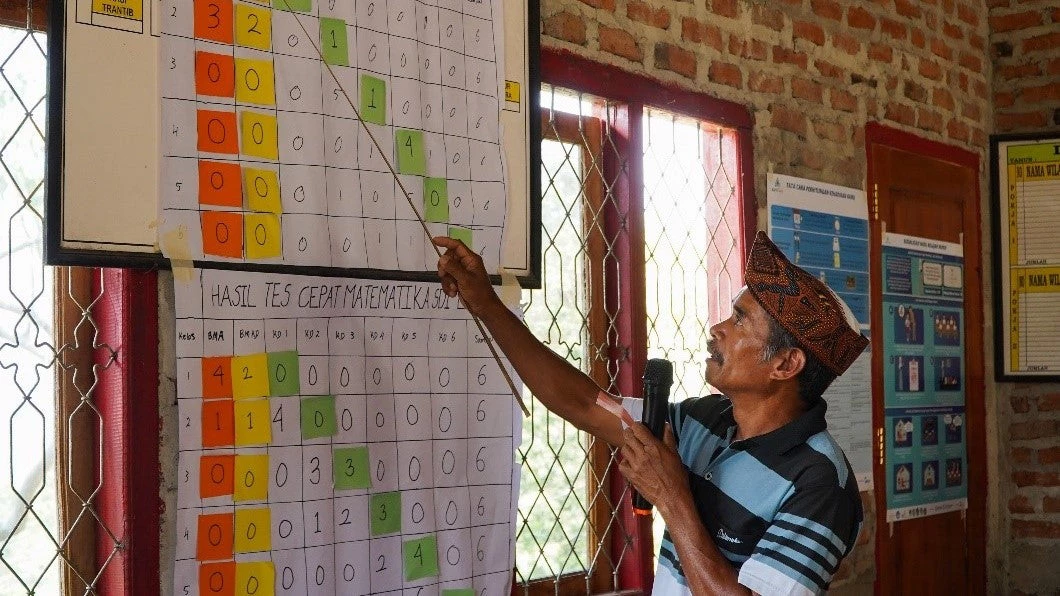 A parent presented the results of the assessment on reading. Only six of 36 students were able to read their grade-level texts; the remaining students’ competence was found to be below their grades, including eight students who were unable to read.
A parent presented the results of the assessment on reading. Only six of 36 students were able to read their grade-level texts; the remaining students’ competence was found to be below their grades, including eight students who were unable to read.
In the past few decades, Indonesian students have not performed well in various international benchmarking tests on education. However, many Indonesian citizens – particularly those in poor, rural, and remote communities – are still unaware of this challenge.
A survey conducted by the World Bank between 2016-2017 in 270 remote primary schools in Indonesia indicated that most students were performing two grade levels below their current grades. Surprisingly, the survey also found that 83% of the students’ parents were satisfied with the schools.
By empowering citizens in remote areas to hold teachers accountable, under the KIAT Guru project, the World Bank supports the government of Indonesia to improve education service delivery in remote villages.
In Indonesia, parents often do not know their children’s learning results compared to students in other classes and in other schools because benchmarked learning outcomes are currently only available through high-stakes national exams at the end of schooling levels.
KIAT Guru introduces an assessment which provides a low-stakes and frequent means to benchmark student aptitude by making learning outcomes comprehensible to citizens. The assessment engages parents to understand the state of learning in KIAT Guru villages, enabling them to take collective action with other stakeholders to support learning.
The test is modeled after citizen-led assessments, a movement pioneered by Pratham’s Annual Status of Education Report in India. Citizen administration of the assessments ensures greater objectivity than administration by internal school actors.
Through easy-to-understand, visual representation of results, stakeholders can appreciate the reading and mathematics achievements of primary school students, as compared to national curriculum targets for their grades. Such visuals are critical to place actionable information into the hands of citizens, empowering them to engage in and make decisions regarding their children’s education. Although teachers are not involved in the test administration, they disseminate the test results in village-wide meetings.
Stakeholders see a simple table as shown below. Six students were selected randomly to represent their grade. If a student’s skills are at her grade level, she is accounted for in the correlated green box. Lagging students are represented to the left of the green boxes, as are those who are illiterate or innumerate.
|
Grade |
Illiterate/ Innumerate |
Below Basic Competency |
1 |
2 |
3 |
4 |
5 |
6 |
Total Students |
|
1 |
5 |
1 |
0 |
0 |
0 |
0 |
0 |
0 |
6 |
|
2 |
3 |
2 |
0 |
1 |
0 |
0 |
0 |
0 |
6 |
|
3 |
0 |
0 |
0 |
5 |
1 |
0 |
0 |
0 |
6 |
|
4 |
0 |
0 |
0 |
0 |
1 |
4 |
1 |
0 |
6 |
|
5 |
0 |
0 |
0 |
1 |
0 |
5 |
0 |
0 |
6 |
|
6 |
0 |
0 |
0 |
0 |
1 |
1 |
4 |
0 |
6 |
Upon seeing the assessment results, parents realized that their children did not have the skills required to perform well in their grades which led parents to demand better performance from teachers and engage more actively in their children’s education.
When results of the assessment were announced to parents and the community for the first time, a parent even asked a teacher: “If my child does not have the necessary reading and math skills, why did you let him progress to the next grade?”
A key feature of the test is its adaptiveness, which allows students less than 30 minutes to complete. Students start the test at their grade level. A correct response will prompt a more difficult question, while an incorrect response will present an easier one. The test progresses according to a student’s ability and concludes with the most difficult question that the student can solve, which mark their grade-level competency.
The assessment addresses the information asymmetry on learning quality between parents and teachers, and education managers and schools, resulting in concrete actions to improve the learning environment in schools and at home.
Unlike other citizen-led assessments, this one does not induce in-classroom learning intervention. Its results are used by citizens and schools to develop a joint agreement, which includes three linked indicators that principals, teachers and parents commit to. These indicators include improving teacher presence, in-classroom and at home learning activities, and remedial learning assistance. With these indicators, teachers and parents can monitor their performance on a monthly basis.
At the end of each semester, the assessment is re-administered to measure progress and inform the revision of the joint agreement for the following semester. As citizens understand the state of education quality, they are empowered to act and influence others around them to collectively bring positive change to learning.
After a year of KIAT Guru program, teachers and parents meeting on learning outcomes increased from 1.8 times to 3 times a year. Student learning outcomes improved from a baseline of 37 to 49 in math (12% increase), and from 37 to 50 in language (13% increase).
Related:
Empowering Frontlines, Leveraging Technology: Basic Service Delivery in 21st century Indonesia




Join the Conversation